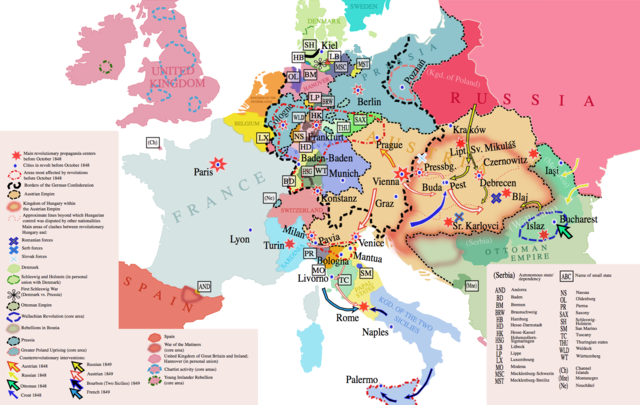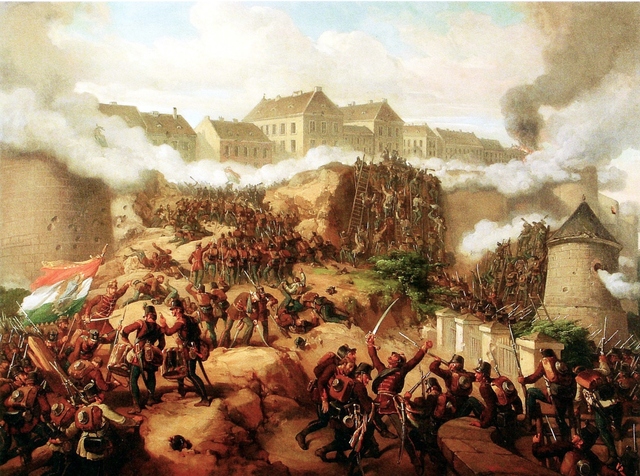The Seeds of the "Springtime of the Peoples:" A Study in the Causes of the Revolutions of 1848
By
2016, Vol. 8 No. 05 | pg. 1/1
IN THIS ARTICLE
KEYWORDS
The year of 1848, as described by Eric Hobsbawm, was painted with the colours of revolution all across continental Europe. Excepting England and Russia, all other states in Europe witnessed a revolution in this year. Thus, this year is popularly known as ‘the springtime of peoples.’ Many historians point out that the Revolutions of 1848 were inspired by two other major events from the prior century: the French Revolution of 1789-1799 and the American Revolution of 1776. Seaman (1976) goes to the extent of arguing that all revolutions of the 19th century evolved from both these revolutions. He says that both of them taught two lessons to the people of Europe. The first was that any people could succeed in a revolution against their king. The second was that revolutions were the means to fulfill the dreams and desires of every nation. It must be noted, however, that he called the outbreak of this Revolution in France a “mistake” and dubs 1848 the “Year of Failure.”2 This paper examines the various sources of discontent within the populations of Europe and explores the major causes of the revolutions that swept across the continent in that year.I: Background for the RevolutionsJacque Droz and many other historians argue that the Revolutions of 1848 were caused by a combination of two factors– political crisis and economic crisis. Let us look at the economic crisis first. The economic crisis is divided into two major crises–agrarian crisis and financial or credit crisis. There is a debate, though, regarding as to which crisis was the prime feature of the economic crisis. Some historians argue that it was the agrarian crisis, which led to a problem of credit; while others say that a credit crisis led to widespread harvest failure. It is, however, clear that in 1839, many regions of Europe saw harvest failure. These include Belgium, Germany, Flanders, Ireland, Scotland, France and so on. Historians agree that it was mainly barley, wheat and potato that failed; and all being staple crops, the crisis was very sharp. Eric Vanhaute points out that the effects of the crisis were not uniform throughout Europe. Many historians like J. Mokyr, A. Maharatna and M. Lachiver state that the crisis was more severe in regions than others. Some of these were regions that were dependent upon a single-crop pattern for agriculture; for example Scotland and Ireland. Other places where the support of the Church and that of the State declined, the peasantry had little help3; making the crisis more taxing, like that in France. Besides these, regions with low industrialization and lesser opportunities for jobs not based in land faced the brunt of the crisis much more.4 Peter Jones elaborates that the food crisis continued till 1846-1847 and sparked off the revolutions. He goes onto highlight how it led to other problems for the cities
Jones goes on to note that the largest portion of the immigrants was male; thus a potential force of “violent rioters” was ready at hand. Thus, it is safe to conclude that the crisis in food production impacted the rural peasant folk and the urban working class the most. Mark Spencer says that the rising poverty due to lower wages and high prices shows how it was mainly the crisis of agriculture that shaped up the discontent amongst the populations, culminating in the revolutions of 1848. However, many other historians like Helge Berge argue that the main cause for the economic decline in Europe lay not in the crisis of food production. It is the crisis in another sector of the economy that they put the main source of the economic malaise in the 1840s–the credit crisis. A 19th century painting by Jakobey Károly depicting the 'Battle of Buda,' which took place in now-Budapest in during the period of the 1848 revolutions. II: The Credit CrisisIn the 1840s, the term ‘capitalism’ began to find space in the realm of the dominant discourse in all of Europe.6 Credit being a key feature of the same, played a major role in the economy. Thus, any crisis in the economy would also be caused by a crisis in the finance and credit sectors. As the 19th century Le Journale des Economistes (ed. by Gillbert Gillaumin) noted, the credit crisis eventually led to the agrarian crisis. In the 1840s, the major investment was primarily in the railways and industry. The landlords chiefly invested in both these emerging sectors; and thus decreased the gross investment in agriculture; leading to an overall decline in the output of land. A huge chunk of land was freed from cultivation (mainly by landlords) and put into the industrial sector. This further lowered the land under cultivation, lowering the total output from land. The states that oversaw the industrialization process gave out bonds and shares to raise money for railways and industries, depleting the state’s share of revenue and money from the treasury. Also, guarantee on credit was virtually absent as land comprised of the major asset against loans; which was in itself in scarcity, as discussed above. Personal loans and borrowings further increased the pressure on the credit system. Thus, the whole mechanism of credit crashed under this enormous weight. Also, this led to a depression in trade and commerce, leading to major discontent amongst the middle classes or the bourgeoisie. The clear demand of this class was thus for more and more policies of Liberalism, as Peter Jones notes.7 However, as Droz argues, the economic crisis was ebbing out by the beginning of 1848. Yet the Revolution happened just after that. Thus, economic factors were not the sole cause of the Revolutions in 1848. A lot of developments in the political realms and the development of newer political theories and ideologies also had an important presence in the years before the revolutions of 1848 broke out. III: Political and Social TensionsHistorian Vivier argues that the economic reasons are not enough to explain the outbreak of the revolutions in 1848. He says that a mix of various crises–political and ideological and social– effected them. The political motivations of the revolutionaries were evident from their demands and their actions in the early phase of the revolution. It must not be forgotten that the forces of Conservatism and Reaction consolidated the period after 1815. Monarchs ruled all countries in Europe and became the targets for the revolutionaries. The first instance of the Revolution was on 12 January 1848 in Naples, Italy. The revolution here was directed against the foreign rule of Ferdinand II of the Spanish-Bourbon dynasty. The main targets were the foreign monarchy and the territorial settlement at the Congress of Vienna (1815). Therefore, the Metternich System was at the head of malcontents. Similarly, in France, on 12 February 1848, barricades were set up in the streets of Paris against Louis Phillip of the Orleans dynasty and his Reactionary prime minister Guizot. The Revolution was up against inadequate political rights of the petite bourgeoisie and the working class and the maladministration of the monarch. There were two dominant trends in the political patterns of the revolution. One was seen in Austria, Italy and Germany, where the revolution was directed against foreign rule and the settlements of the Congress of Vienna. Meanwhile, France, Switzerland, Spain and Portugal saw revolutions against inadequate rights and inconsistent policies of the parliament. Thus the revolutions followed two major patterns and sets of grievances. As Peter Stearnes argues, some major political strands or ideologies emerged and influenced the Revolutions. The first was that of the Liberals. They believed in the ideas of Liberalism as forwarded by many intellectuals in the 18th century. They had a more or less moderate goal, i.e. they wanted a constitutional monarchy. However, they were weary of leading the revolution as they viewed the 1789 Revolution in France as a major catastrophe. Besides, they wanted a limited representation and a small base of suffrage, based on ownership of property and education. The other faction was that of the Radicals. They were an offshoot of the liberals but looked at a more radical goal, that of total Republicanism. Peter Stearns elaborates that
Thus, it is clear that the Radical method of achieving the goal was only and only revolution. Thus, many a Radical leaders also played a key role during the Revolutions of 1848. Another group of moderates emerged in the Nationalists. They believed in the supremacy of the nation over the individual; however, they agreed with the Liberals that civil liberties must be ensured by the state upon its citizens. However, as Mazzini, a thorough Nationalist, theorized, the liberation of the nation is a precursor to the endowment of liberty to the people. The Nationalists thus looked to promote ‘national culture’, which was based in language and historical consciousness.9 This idea held special space in Italy and Germany later in the century as they were to be politically unified. A minor group within Italy emerged, called the Neo-Guelfs. They supported the Papal authority and sought to restore the Roman Catholic Church in all its glory by establishing a Papal Federation. The Neo-Guelfs held some stand in the middle quarters of the century; but lost out in the ultimate political framework almost a decade after the Italian Unification under Cavour and Garibaldi. Although there were many differences amongst these ideological groups, it is clear that they had some common features. They were all looking to gain self-determination, as opposed to the Metternich System and monarchical governments. All of them upheld liberal civil rights for a wider section of the population; and thus worked to establish a parliament and a constituent assembly after the easy surrender of the monarchical forces in early 1848. Thus it can safely be argued that they were all nationalistic in nature. It must here be noted that C.A. Bayly identifies this whole period as the period of nation formation in terms of modernity and global history; thus, the importance of the rise of nationalist ideas cannot be ignored here. Another nascent force of politics was to be seen in Socialism and Communism. By 1848, the socialists had cemented their place in the political sphere of Europe and were an undeniable presence. Karl Marx and Friedrich Engels also published their Manifesto of the Communist Party in February of 1848. The influence of the socialist ideas was seen widely growing, especially amongst the students and teachers at the big universities in Europe. However, it is clear from the examples above that political aspirations and ideological strands were not a prime mover when it comes to the 1848 revolutions as there is little space for their being as widely affective as something like food crisis or rising poverty. Thus, scholars have turned to other social factors to look for the major causes of the outbreak of the 1848 revolutions. IV: Class ConflictAlthough it is true that the socio-economic antagonisms in all the countries of Europe were not uniform, it is also true that the everyday existence of the social classes was not very different from the days of the ancient regime. As may be evident, certain classes like the bourgeoisie, the working class, the petty bourgeoisie, the mercantile and professional bourgeoisies, the peasantry, landlords, aristocrats and monarchs were present in all countries of Europe at this point in time. This has led many scholars to argue that it was in the social antagonisms that the major causes for the outbreak of the Revolutions lie. William Langer, Eric Hobsbawm, George Rudé, Peter Jones, Arnost Klima and many others argue that it was the poor condition of the working class that caused the 1848 revolutions.10 Industrial antagonisms, as they argue, defined the everyday experience of the workers; the situation was same in almost all of Europe. Widespread malnourishment, low wages, disease, lack of civil rights, access to healthcare and poor living conditions characterized the life of a worker. Peter Jones goes on to explain that the revolutionary consciousness emerged from the rising working class consciousness as an effect of the Industrial Revolution. However, Peter Stearns points out that the working class consciousness didn’t exist in 1848. The industrial revolution, he says, was not important in 1848; it was in its nascent stages. The regions of industrialization were mostly in the peripheries of the towns; but it was the towns that proved to be a center for the revolutions, cutting off the workers from the barricades. Besides, the condition of workers was so miserable that they had little mobilization amongst them for a revolutionary cause, per se. He points out that the key group of protestors in the Revolution was that of the artisans, not the workers. The artisans were aggrieved by the breakdown of the guild workshops and high competition from the factory produced goods. The greatest fear of the artisans was that of proletarianisation. Thus, they attacked both the capitalists and nobility as well as the proletariat11 during the confrontations at the barricade, especially in Vienna, Berlin, Paris and Milan. Stearns also looks into the participation of the peasantry in the Revolutions and he argues that it was very little. There were many causes for discontent amongst the peasantry, unemployment12 being one of them. However, whence the revolution came, the landlords were divided into either revolutionary or feudal; the majority being that of the latter. And due to fears and insecurities of the city life and urban occupations, the peasantry flocked to their landlords. Thus, they didn’t participate in the revolutionary activities. It is here, he traces the ultimate failure of the bourgeoisie in 1848–its inability to incorporate the peasantry within the movement. The bourgeoisie itself led the revolutions of 1848 by virtue of being the ‘enlightened’ class. As Eric Hobsbawm puts is, the bourgeoisie organised the revolutions; which were enforced by the laboring masses of workers and artisans. The grande bourgeoisie or the capitalists wanted more representation and participation in the state. The middle of professional bourgeoisie wanted greater suffrage. The petty or petite bourgeoisie wanted lower taxes and better communications in railways, telegraphs etc. Lewis B. Namier calls the revolutions of 1848 the “revolutions of intellectuals” as he sees the revolutions engineered by the enlightened bourgeoisie; who also carried forward the revolutions after the repression of the barricades by the state machinery. Examples of enlightened intellectual leaders are found in almost all revolutions–Palicqui, Robert Bloom, Mazzini, Dahlmann et al. But, Karl Marx argues that all of them betrayed the revolution. Marx writes that most of them were liberals, thus, ready to enter into a compromise with the monarchs and governments on their own terms. This betrayed the demands of the proletariat and sidelined all aspirations of the muscle power of the revolution; thus betraying the revolution itself, by helping counter-revolution regain ground later in the year. Arnost Klima, however, argues that even though counter-revolution won, it did not slip back into old feudal structures. Civil liberties were established in perpetuity. At the same time Sperber, Stearns and David Thomson, as elaborated above, argued that the sole reason for the failure of the bourgeoisie was the lack of mobilization of the peasantry; the proletariat, they argue, was not involved in the movement in a big way at all. However, L.C.B. Seaman points out that if the peasantry were to take part in the revolution, it would have proved to be a burden as it was highly volatile and disorganized a group to be relied upon. Another major unorganized and disoriented social category was that of the clergy and the Church. Due to their repression by various groups ever since the days of the French Revolution of 1789, they had brewing discontent against the state structure. To address this, they actively supported the Revolutions to topple the governments. As discussed above, this also led to the rise of the Neo-Guelfs. Widespread attacks on the church, clergymen and followers led to the active role of these groups, especially in Bavaria (Protestant soldiers against the Catholic state) and Prussia (divisions amongst the armed forces on religious lines due to enforcement of Protestant sacraments). Anti-Semitism also played a key role in mobilising religious groups in the Revolutions. To sum up, Peter Jones says that socio-economic causes can only be seen as an indirect cause of the revolutions of 1848. They were slow to form the backgrounds of the revolutions. Due to newer changes, newer conflicts kept arising. V: ConclusionThe 1848 Revolutions were marked by popular upheaval. The causes for discontent were many, as were the responses to these by both groups–the governments and the revolutionaries. Although this year saw a one-of-a-kind “divine violence” (as conceptualized by Walter Benjamin) on this large a scale, the revolutions failed in all places except for France. Many historians have debated the possible causes for the failure of the Revolutions of 1848. But most of them agree that this was a unique revolutionary period, where a huge number of people of an entire continent, rose up in revolution, to get what they dreamed and achieve what they aspired. Perhaps, Jonathan Sperber offers the best reading of this phase of revolutions by looking at it in a most unique way,
It is for us to “ponder” as to what lessons we might learn today from the revolutions that shaped the future of European politics. While the contemporary politics and culture of Europe finds its roots in two major revolutions–178914 and 191915; however, it is 1848 that lent true character to Europe; its failure lay in its being in between these two, as Sperber argues, and not being able to be authentically closer to either of the two revolutions preceding it. If one may take the risk, it can also be seen as a major precursor to the two most devastating events of the modern world–The First World War (1914-1919) and The Second World War (1939-1945). ReferencesHobsbawm, Eric Age of Capital: 1848-1875 (2012, Abacus, London). Jones, Peter The 1848 Revolutions (1981, Longman Group Ltd., Essex). Seaman, L.C.B. From Vienne to Versailles (1976, Methuen & Co. Ltd., Kent). Sperber, Jonathan The European Revolutions, 1848-1851 (1994, Cambridge University Press, Cambridge). Stearns, Peter N. 1848: The Revolutionary Tide in Europe (1974, W.W.Norton, New York). Endnotes1.) Hobsbawm, Eric Age of Capital: 1848-1875 (2012, Abacus, London), p. 22. 2.) Seaman, L.C.B. From Vienne to Versailles (1976, Methuen & Co. Ltd., Kent), pp. 49-55. This is because all revolutions in 1848 (except for France) failed to achieve their goals. 3.) The Church was a safe haven for the rural peasant-folk since medieval times. They could go there for shelter and food in times of crisis; the moral support was an added bonus. The city life for these fleeing rural populations was highly alienating and perplexing. The State, too, was a ray of hope as in times of crisis, it usually wavered or at least lowered the taxes for the peasantry. However, owing to a downward trend in the overall economy, this was not seen in many regions. 4.) In these places, there were very little opportunities for the declining peasantry to move out of land and look for jobs in towns and factories. Thus, the rate of unemployment remained very high. 5.) Jones, Peter The 1848 Revolutions (1981, Longman Group Ltd., Essex), pp. 28-29. Jones here notes that due to the brutality of the life of the proletariat, the arrival of fresh labour meant an increase in competition and conflict between the immigrants and the existing proletarian populace. Besides, about 70% income of working class families was spent on food; making them all the more susceptible to the food crisis. 6.) Hobsbawm, Eric Age of Capital: 1848-1875, Introduction (2012, Abacus, London), p. 13. 7.) Jones, Peter The 1848 Revolutions (1981, Longman Group Ltd., Essex), pp. 30-31. 8.) Stearns, Peter N. 1848: The Revolutionary Tide in Europe (1974, W.W.Norton, New York) p. 47. 9.) Ibid. This analysis of Stearns is clearly seen the theorizations of nationalism by Ernest Renan. 10.) So high is the importance of the worker in the revolutions that Marx calls the June Days in France the 1848 revolutions in general, the preludes to the Proletarian Revolution. In this list, he later added the Paris Commune of 1871. 11.) Jonathan Sperber points out that it was the proletariat that formed the social base of the National Guard along with landless labourers who had lost their livelihood in the agrarian crisis. Thus, a significant section of the proletariat was pitted against the artisans, going by what Peter Stearns argues. 12.) Amongst various other causes, this was also caused by the abolition of serfdom. As a result a large number of serfs were now free. However, most of them chose to stay in villages, owing to insecurities of urban life. 13.) Sperber, Jonathan The European Revolutions, 1848-1851 (1994, Cambridge University Press, Cambridge) 14.) The French Revolution; bourgeois in nature. 15.) The Russian Revolution; proletarian in nature. Suggested Reading from Inquiries Journal
Inquiries Journal provides undergraduate and graduate students around the world a platform for the wide dissemination of academic work over a range of core disciplines. Representing the work of students from hundreds of institutions around the globe, Inquiries Journal's large database of academic articles is completely free. Learn more | Blog | Submit Latest in History |




















